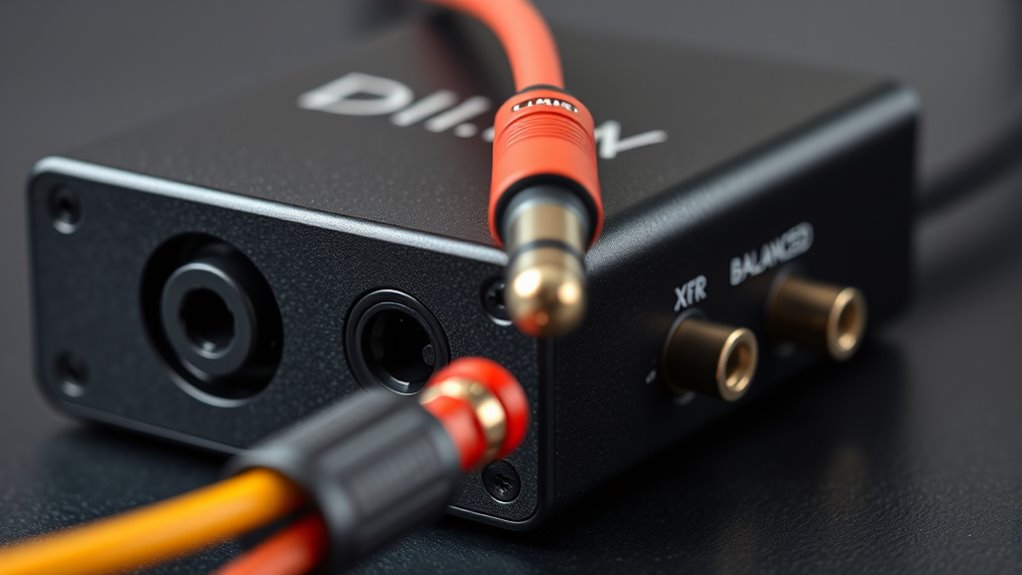DI boxes help you connect high-impedance, unbalanced sources like guitars or keyboards to balanced inputs on mixers or audio interfaces. They convert signals to low-impedance, balanced formats, reducing noise and signal loss over long cables. This process guarantees your sound stays clear and strong. Choosing the right DI box depends on your equipment’s impedance needs. Keep exploring; you’ll find more details on how these tools optimize your audio setup.
Key Takeaways
- DI boxes convert unbalanced, high-impedance signals into balanced, low-impedance outputs for compatibility and noise reduction.
- Balanced connections use two conductors and a ground to cancel out interference and improve signal integrity.
- Proper impedance matching ensures minimal signal loss and prevents distortion across audio equipment.
- DI boxes are essential for connecting instruments like guitars to professional audio gear while maintaining sound quality.
- Selecting the right DI box involves considering impedance handling and the specific requirements of your audio setup.

Another critical aspect of using DI boxes effectively is impedance matching. Different audio sources and input devices have varying impedance levels, and mismatched impedances can lead to signal loss, distortion, or a weak audio signal. DI boxes help solve this by converting high-impedance, unbalanced signals (like from guitars or keyboards) into low-impedance, balanced signals suitable for mixing consoles or audio interfaces. Proper impedance matching ensures your sound remains clear and detailed, preserving the integrity of the original source. When selecting a DI box, check its specifications to make sure it can handle the impedance levels of your equipment, guaranteeing peak performance. Additionally, understanding industry trends can help you choose the most versatile and future-proof DI solutions.
Frequently Asked Questions
Can DI Boxes Improve Sound Quality in Live Performances?
Yes, DI boxes can improve sound quality in live performances by maintaining signal integrity and reducing issues like ground loops. They convert unbalanced instrument signals into balanced ones, minimizing noise and hum. This helps guarantee your sound remains clear and clean, especially when connecting to distant or complex audio systems. Using a DI box ultimately delivers a more professional and reliable performance, keeping your sound consistent and free from unwanted interference.
Are Balanced Connections Necessary for All Audio Setups?
Balanced connections aren’t necessary for all audio setups, but they substantially reduce issues like ground loops and noise caused by inadequate cable shielding. If you’re working in a noisy environment or using long cable runs, using balanced connections helps maintain sound quality. However, for simple setups with short cables and minimal interference, unbalanced connections might suffice. Always consider your environment and equipment to decide what’s best.
How Do I Choose the Right DI Box for My Instrument?
You should choose a DI box that matches your instrument’s impedance and power needs. Did you know that mismatched impedance can reduce sound quality by up to 30%? To pick the right DI box, check your instrument’s impedance, usually listed in the manual, and guarantee it’s compatible. Consider whether your instrument requires phantom power or a battery, and select a DI box that suits those power requirements for ideal performance.
What Are Common Issues With Unbalanced Audio Cables?
Unbalanced audio cables often face issues like ground loops, which cause hum or buzz, and signal degradation, leading to poor sound quality. You might notice increased noise or loss of clarity, especially over longer cable runs. To avoid these problems, keep cables short, guarantee proper grounding, and consider using DI boxes or balanced connections. Regularly check your cables for damage to maintain clear, noise-free audio.
Do Passive and Active DI Boxes Sound DIfferent?
Passive and active DI boxes do sound different because they handle impedance matching and noise reduction differently. Passive DI boxes rely on transformers, offering warmer tones and better noise rejection, especially with high-impedance sources. Active DI boxes use power and electronics, providing cleaner, more transparent sound and improved headroom. Your choice depends on your instrument and sound preference, but both aim to optimize signal quality by reducing noise and matching impedance.
Conclusion
So, it’s pretty amazing how DI boxes and balanced connections often come into play when you least expect it, like during a live gig or recording session. They’re the quiet heroes that prevent hums and noise from sneaking in, making your sound crystal clear. Next time you set up your gear, remember that these tools are more than just technical details—they’re the coincidence that keeps your music sounding professional and polished, every single time.









